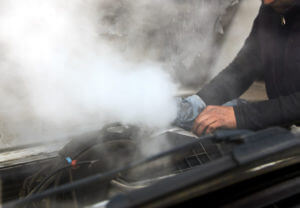Car overheats troubleshooting tips
How to diagnose a car overheats condition
When your car overheats you can easily narrow  down the possible causes by following this guide. Overheating can be caused by:
down the possible causes by following this guide. Overheating can be caused by:
Low coolant

Check coolant level in recervoir
Inoperative radiator fans or improper radiator fan speed (some fans are variable or multi-speed)
Worn water pump
Clogged radiator
Stuck closed or partially closed thermostat
Coolant Restriction somewhere in the cooling system.
Start by checking coolant level
Low coolant levels can cause all kinds of problems, so start by checking the coolant level at the reservoir.
Then check radiator fan operation
When your temperature gauge is in the hot zone your radiator fan should be running full blast. If you have two radiator fans, both should be running at their highest speed. If they’re not running when the temp gauge is hot, check for a blown fuse or a bad cooling fan relay
One sign of an inoperative radiator fan is an engine that overheats at idle but not when driven at highway speeds. At highway speeds, ram air is enough to cool. But once you’re at idle, the inoperative radiator fans cause overheating.
Check the temperature of the radiator hoses
Gently touch both the upper and lower radiator hoses while the engine is in an overheat condition. The lower radiator hose should feel cooler to the touch than the upper hose. A cooler lower radiator hose confirms that the radiator is not plugged and the radiator fans are working properly. If the hoses feel the same, the cause can be a plugged radiator or a bad water pump. The next test will tell you which one is the cause.
If both radiator hoses are cool or cold to the touch, the cause may be a worn or missing water pump impeller, lose coolant or a stuck closed thermostat (not allowing hot coolant to flow out of the engine). If you’ve recently opened the cooling system but didn’t properly bleed the air, you may have an air pocket that’s preventing the thermostat from opening.
If you suspect a clogged radiator, try this test: Disconnect the upper and lower radiator hoses. Place a five gallon bucket under the lower radiator hose outlet. Then shove a garden hose into the upper radiator hose inlet. Turn the water on high enough to keep the radiator full. A good radiation should flow enough water to fill a five-gallon bucket completely in one minute.
Flow cold water over the radiator.
Hold a garden hose over the radiator and flood the radiator while running the engine. If engine temperature drops, the test confirms that the water pump is working but the radiator is at least partially plugged.
You can find where the restriction is by using a non-contact infra-red thermometer. Just scan the surface of the radiator core and look for cool spots. Those are restrictions that are preventing full cooling. In most cases the fix is a cooling system flush and a new radiator.
©, 2019 Rick Muscoplat
Posted on by Rick Muscoplat
